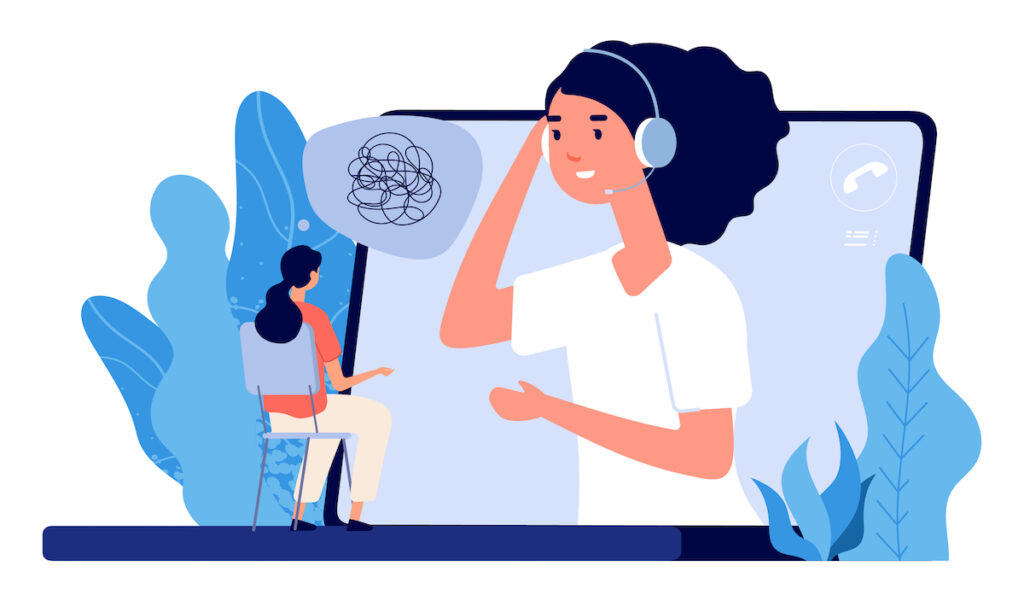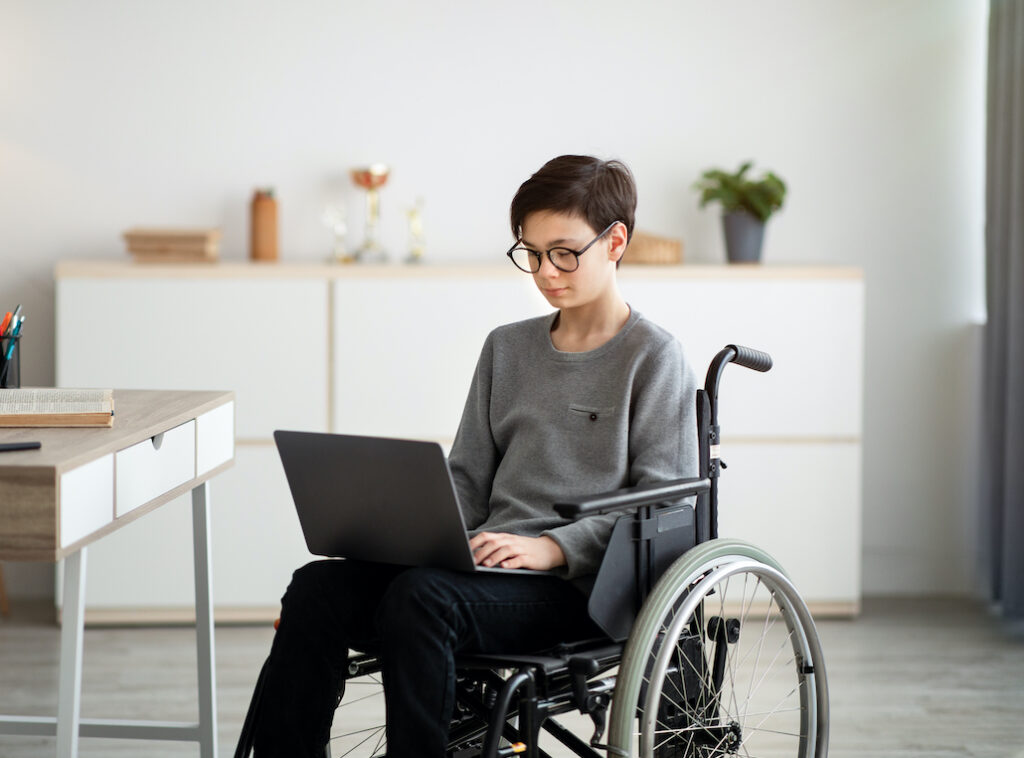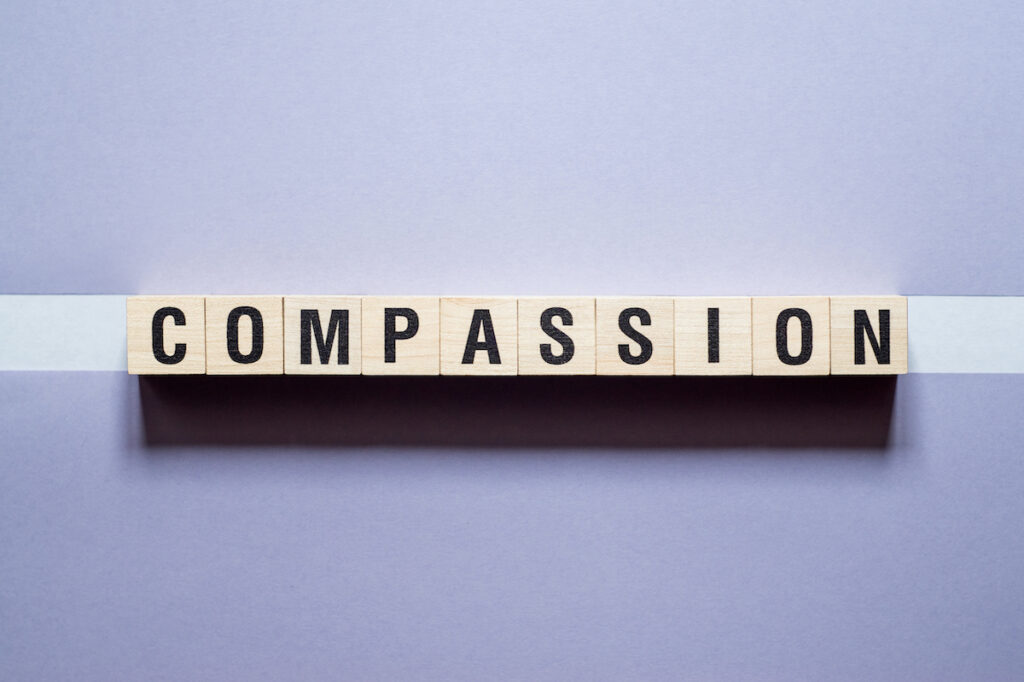
Research suggests that a mutual relationship between a client and therapist is essential for good treatment outcomes (Castonguay et al., 1996; Duncan, 2010; Messer & Wampold, 2002).
The therapeutic relationship, also as known as therapeutic alliance, has three parts, i.e., 1) bond (emotional connection); 2) tasks (small steps to work on together), and 3) goals (overall goals of therapy; Bordin, 1979).
Most evidence is from studies evaluating therapeutic alliance during the course of physical treatment sessions (in-person). Nevertheless, remote provision of mental health support has been in existence for some time, particularly in remote areas of high-income countries, and is an area that was already gaining traction (Dores et al., 2022). By remote provision, we mean therapeutic support sessions that are conducted on the phone, via email, online text chats or video-conferencing. The global COVID-19 pandemic meant that much in-person provision was rapidly moved to remote in many circumstances (Perrin et al, 2020). A natural concern about this may have been the ability to form relationships in this way.
Previous research has explored online therapeutic alliance and demonstrated it to be highly rated by clients (e.g., Hanley, 2009; King et al., 2006), but most research in this area is also focused on adults (e.g., Simpson & Reid, 2014). Also, there has been little recent comparison between in-person and remote provision for youth mental health support.
The aims of a recent US study (Frye et al, 2021) were to a) assess young people’s ratings of therapeutic alliance across in-person and remote settings and (b) describe potential savings in time and cost for remote support.

A therapeutic alliance is a mutual relationship between a client and therapist. Has the shift to remote settings during the pandemic impacted the therapeutic relationship with young people?
Methods
Frye and colleagues (2021) conducted a small naturalistic study of 50 patients who attended an outpatients therapy service at an academic therapy centre in the USA. Participants received psychology services either in-person (n = 33; 66% of the sample), via videoconferencing sessions (n = 6; 10% of the sample), or a combination (n = 11; 22% of the sample). Participants were mainly female (80%), with a mean age of 16.5 years, and 78% were Caucasian.
An online version of a measure of therapeutic alliance (the Session Rating Scale; Duncan et al., 2003) was completed either after every session (videoconferencing sessions) or every other session (in-person).
While the sample is relatively small and non-diverse, we are not aware of any other recent research which has compared young people’s therapeutic alliance ratings across remote and in-person settings (a review identified a couple focused on youth, also with small sample sizes, see Simpson & Reid, 2014). This research is very timely, with the speedily implemented move to remote provision in light of the ongoing COVID-19 pandemic.
Results
Based on the ratings from 50 participants following 120 in-person sessions (65.5% of the ratings) and 63 remote sessions (34.4% of the ratings), the authors found that all participants rated therapeutic alliance highly. The high ratings imply that a good working relationship between the therapist(s) and clients was established. Also, clients had an increased perception of the relationship, goals, therapist approach and were overall satisfied with services received. There were no discernible differences in the ratings across the setting types nor between the ratings of clients who attended both remote and in-person sessions.
Given that the sample was not diverse (mostly white young women), it is difficult to generalise these findings to a broader population. However, the study offers key insights into the stability of therapeutic alliance across face to face and remote/digital mental health provision, which has been a concern amongst professionals (Olwill et al., 2021).
While a very similar number of clients attended in-person sessions and remote sessions, only those who attended the remote sessions were asked why they did not show up. The reasons included, e.g., forgetting about the appointment and having a poor internet connection. Finally, the authors found that attending remote sessions saved participants around $22 per session in time and travel costs, compared to if they had attended in-person sessions.

The initial findings from this small study suggest that young client-therapist therapeutic alliance may be equally positive in remote and in-person mental health interventions.
Conclusions
The authors concluded:
As TMH [telemental health, or remote sessions] becomes an increasingly common practice with technological advances and its use during the COVID-19 pandemic, further research is needed to determine the best practices in the training and application of telehealth for psychologists providing TMH (Perrin et al., 2020).

Whilst the results of the study are promising, more research is needed, particularly into best practices for remote provision, including training for therapists and clinical psychologists.
Strengths and limitations
One of the main limitations of this paper is the small and homogenous sample size. In particular, it is not made particularly clear that the study’s main findings are based on a subsample (N=11) of an already small sample. That sample is based on those participants who were seen for both in-person and remote sessions. It is unclear whether those eleven clients were seen by the same therapists for their in-person and remote sessions. Therefore, it is unknown how much of the therapeutic alliance is attributable to the different settings, i.e., had they already built up a relationship in-person then moved to remote sessions? Thus, the remote therapeutic alliance may have been an extension of an existing relationship, which is a different research question.
There is a theme running through both of our active ingredients reviews (see below) that there is a real lack of evidence in this area. Therapeutic alliance research is primarily focused on adults, and there is very little from the youth field. So, while we are aware that an abundance of caution should be applied to the interpretation and potential generalisation of the findings of this study, we have focused on it as an example of emerging evidence and thought.
There are also challenges associated with measuring therapeutic alliance, due to the very nature of rating a live relationship, and in general, ratings of therapeutic alliance (similar to ratings of service satisfaction) tend to be high. The ratings are likely to be subject to bias, depending on how the measures were completed and whether clients thought their therapist would see the scores. This level of detail was not available in the study.

We don’t know much about the therapeutic alliance with young people, but consideration is needed when we measure this relationship in research.
Implications for practice
The implications here are that these small-scale findings suggest that an equitable therapeutic alliance is achievable regardless of whether the input is delivered in-person or remotely. However, the authors note that further research is required to explore therapeutic alliance when participants do not choose to have their input remotely and whether there are any differences across therapeutic intervention types being delivered.
This study provides key support for clients and therapists’ ability to continue to build positive therapeutic alliances in remote sessions to the same level that is achievable in-person. If further research is in support of these findings, there are wide-reaching practice implications, including the feasibility of the expansion of remote support beyond the current COVID-19 pandemic, to clients who are unable to easily (or at all) attend in-person sessions, for example, those in geographically remote areas (with access to phones/computers), and those with chronic illnesses and disabilities.

Similar levels of therapeutic alliance can be achieved remotely, as well as it is more accessible to clients with disabilities or chronic illness.
Our Active Ingredients reviews: Working alliance, Collaborative goal setting and tracking
While the study by Frye et al (2021) focused on comparisons of therapeutic alliance ratings in different settings, both of our Wellcome Trust funded active ingredients reviews were more general in focus.
Working alliance – Jermaine Dambi and colleagues
The first review explored how therapeutic alliance influences treatment outcomes for young people aged 14-24 years experiencing depression or anxiety. This review also explored how therapists and clients’ characteristics influence treatment outcomes.
The review found that a greater therapeutic alliance is associated with improvements in depression and anxiety symptoms in young people across different contexts. Best treatment outcomes are mainly realised when a therapeutic alliance has been established early in treatment. Young people expressed the need to be understood and be part of the decision-making process to improve the therapeutic alliance. Also, both therapists and young people with lived experience agreed that empathy, communication, respect, and confidentiality are critical in forming and maintaining a therapeutic alliance. However, ruptures in therapeutic alliance seem to negatively affect treatment expectancy and adherence, reducing treatment effectiveness.
Collaborative goal setting and tracking – Jenna Jacob and colleagues
The second review was focused on the goals element of a therapeutic alliance. We combined a literature review with consultation with experts by experience (young people with lived experience and academics/therapists), and found that overall, goal setting is helpful to young people experiencing anxiety or depression because it helps build a good therapeutic alliance through open communication and building trust. This emphasis on communication links to the findings of the first review.
We found that goal setting can help to make things feel more manageable, enabling young people to feel supported and have ownership of their care. There were several limiting factors to goal setting that we could identify, which were linked to individual preferences, or negative past experiences of goal setting. We also found that contextual factors including country and long-term therapy were key to whether young people found goal setting a valuable element of the therapeutic alliance. We found that while there was not a lot of literature we could draw upon, the emphasis on the voices of young people in the research was both prominent and of paramount importance.
Both reviews employed a participatory action style of research, where young people were central to the design and delivery. This included creating advisory groups and involving them in all stages of the research. Of particular relevance was the discussion of the literature and advisory group discussions, which provided contextual depth and understanding. There were elements of our findings that highlight the importance of engaging the advisory groups. For example, in the goals project, youth advisors said the most crucial element in therapy is open communication and trust with therapists. Some said that agreeing on goals had helped them build trust with their therapist, which led them to have a better experience of therapy, including positive outcomes. Other youth advisors said the trust had to come first. It was important for therapists to work on the relationship before they felt able to share goals with them.
Our reviews align with the other active ingredients projects, for example, those focused on “A sense of purpose” led by Dr Emily Hielscher (Australia), “Agency: participation in social action” led by Mariana Steffen (Brazil), and “Emotional controllability” led by Dr Matt Somerville (UK).
Goal setting considerations
Our findings also lend themselves to a few considerations moving forward:
- For clinical practice, young people’s preferences to work on goals or not must be given priority.
- For research, priority must be given to exploring unhelpful mechanisms of goal setting and ways to attain a therapeutic alliance across all stages of the therapeutic process, i.e., early-, mid-and late sessions. Understanding the mechanisms is essential to avoid potentially harmful effects and advise clinical practice.
- For policy, cultural considerations are likely to be a limiting factor in some places, hence the need to explore ways of promoting goal setting and the therapeutic alliance in psychotherapies in different health care systems/contexts.
We will shortly submit our reviews for publication, so watch this space for our full findings, interpretations and recommendations for practice, research and policy!

Young people expressed the need to feel understood and involved as important to the therapeutic alliance with their therapist.
Statement of interests
There are no conflicts of interest for the authors in writing this article.
Links
Primary paper
Frye, W. S., Gardner, L., & Mateus, J. S. (2021). Utilising telemental health in a paediatric outpatient psychology clinic: Therapeutic alliance and outcomes. Counselling and Psychotherapy Research.
Other references
Bordin, E. S. (1979). The generalizability of the psychoanalytic concept of the working alliance. Psychotherapy: Theory, Research & Practice, 16(3), 252.
Castonguay, L. G., Goldfried, M. R., Wiser, S., Raue, P. J., & Hayes, A. M. (1996). Predicting the effect of cognitive therapy for depression: a study of unique and common factors. Journal of consulting and clinical psychology, 64(3), 497.
Duncan, B.L. (2010). The heart and soul of change second edition: Delivering what works in therapy. Washington: American Psychological Association
Dores, A. R., Geraldo, A., & Martins, H. (2022). The Road to Digitally-Driven Mental Health Services: Remote Psychological Interventions. In Digital Therapies in Psychosocial Rehabilitation and Mental Health (pp. 42-71). IGI Global.
Hanley, T. (2009). The working alliance in online therapy with young people: Preliminary findings. British Journal of Guidance & Counselling, 37(3), 257-269.
King, R., Bambling, M., Reid, W., & Thomas, I. (2006). Telephone and online counselling for young people: A naturalistic comparison of session outcome, session impact and therapeutic alliance. Counselling and Psychotherapy Research, 6(3), 175-181.
Messer, S. B., & Wampold, B. E. (2002). Let’s face facts: Common factors are more potent than specific therapy ingredients. Clinical psychology: Science and practice, 9(1), 21-25.
Olwill, C., Mc Nally, D., & Douglas, L. (2021). Psychiatrist experience of remote consultations by telephone in an outpatient psychiatric department during the COVID-19 pandemic. Irish journal of psychological medicine, 38(2), 132-139.
Perrin, P. B., Rybarczyk, B. D., Pierce, B. S., Jones, H. A., Shaffer, C., & Islam, L. (2020). Rapid telepsychology deployment during the COVID‐19 pandemic: A special issue commentary and lessons from primary care psychology training. Journal of clinical psychology, 76(6), 1173-1185.
Simpson, S. G., & Reid, C. L. (2014). Therapeutic alliance in videoconferencing psychotherapy: A review. Australian Journal of Rural Health, 22(6), 280-299.
Photo credits
- Photo by Zoe on Unsplash
- Photo by Marcos Luiz Photograph on Unsplash
- Photo by Charles Deluvio on Unsplash
- Photo by Ronnie Overgoor on Unsplash
- Photo by Tiago Felipe Ferreira on Unsplash

Good luck, Jenna and Jermaine!
Good to see your material connects with the other active ingredients projects for young people and their therapeutic alliances.